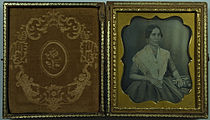Daguerreotype
 |
|
|
|
Daguerreotype (/dəˈɡɛrəˌtaɪp, -roʊ-, -riə-, -rioʊ-/;French: daguerréotype) process, or daguerreotypy, was the first publicly announced photographic process, and for nearly twenty years it was the one most commonly used.
Invented by Louis-Jaques-Mandé Daguerre and introduced worldwide in 1839, daguerreotypy was almost completely superseded by 1860 with new, less expensive processes yielding more readily viewable images. During the past few decades, there has been a small-scale revival of daguerreotypy among photographers interested in making artistic use of early photographic processes.
To make a daguerreotype, the daguerreotypist would polish a sheet of silver-plated copper to a mirror finish, treat it with fumes that made its surface light sensitive, expose it in a camera for as long as was judged to be necessary, which could be as little as a few seconds for brightly sunlit subjects or much longer with less intense lighting; make the resulting latent image on it visible by fuming it with mercury vapor; remove its sensitivity to light by liquid chemical treatment, rinse and dry it, then seal the easily marred result behind glass in a protective enclosure.
...
Wikipedia
